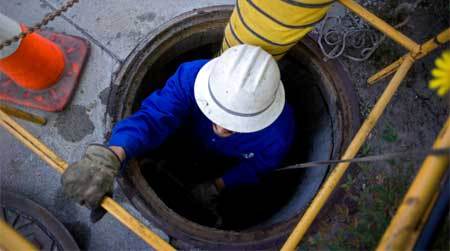Preventing a Confined Space Becoming a Trap
The HSE define a confined space as a place which is substantially enclosed (though not always entirely), and were serious injury can occur from hazardous substances or conditions within the space or nearby (e.g. lack of oxygen). A good example is the interior storage of a tank, which may be occasionally entered by workers for maintenance but is otherwise not a habitable space.
Safety problems usually arise during maintenance procedures when the equipment is either being repaired or cleaned, and is automatically switched back on because no-one knew an engineer was inside. At this point a routine maintenance procedure can turn into a horrific trap.
Adopting a permit to work is a recommended way of preventing these accidents – it clearly allocates responsibilities and makes employees run through a series of standard checks to protect workers.
Matching the Person to the Job
Firstly check whether the people assigned to the task are right for the work. Are they trained or hold the appropriate qualifications for the job? Even if it’s an external contractor you still have a reasonable duty to assess their competence.
The Working Environment
Oxygen Levels
Monitoring the atmosphere is one of the most important rules and should be done before anyone enters a confined space. Exposure to toxic gases is a common factor in confined space accidents. Earlier this year a Dorset farm owner was fined for serious safety failings after a worker died during maintenance of an anaerobic digestion (AD) plant at the farm and became engulfed by toxic hydrogen sulphide gas.
Ventilation
If the space contains or is likely to contain toxic gases, plan for how the area can be ventilated or the gas removed before sending someone in. Forced-air ventilation is generally the most effective approach as this technique dilutes and displaces any atmospheric contaminants.

Isolation and Lock Out
Isolating the space should include Locking Out all powered devices associated with the area such as electrical, pneumatic, hydraulic and gaseous agent fire control systems.
A Lock Out system also ensures that when equipment is being worked on, the energy supply can't be turned back on and injure anyone working on the equipment. It's a recognised safety procedure and is backed up by Electricity at Work Regulations 1989 and PUWER 1998 legislation, which require equipment to be made safe before it is worked on. A Lock Out system can incorporate:
* A switch or other mechanism being put in the off or safe position
* A padlock attached to the mechanism to prevent the machine being re-energised (one padlock should be attached by every person working on the machine)
* A tag attached to the mechanism as a written warning that it is locked out
* The tag should be durable and substantial so that it does not come off easily and capable of identifying the person who applied it.
Protective Workwear
Make sure the worker wears personal protective equipment (PPE). PPE is the last line of defence and is essential where hazards cannot be eliminated or controlled by other means.
Support
Emergency Plans
You’ve made the situation as safe as you reasonably can, the next step is to put in place an effective contingency procedure should an emergency arise. Although contingency plans will be dependent on the nature of the confined space, obvious areas to address are rescue and resuscitation equipment.
Communication
It is essential that communication is maintained between the people inside the confined space and the people outside so that help can be contacted quickly and easily. Consider positioning someone outside the space to keep watch and raise the alarm quickly and initiate any rescue/emergency procedures.
Jason Allison, SG World Customer Insight Specialist, re-iterated the importance of using Permits to Work safely in confined spaces. "SG World offer electronic and paper based Permit to Work systems - Confined Spaces is one of our most popular products. It gives our customers a formal, structured way of managing jobs in confined spaces and ensures all involved take the measures required to prevent a potentially very nasty accident."
About Lisa Robinson
Lisa - word smith to the gods.
